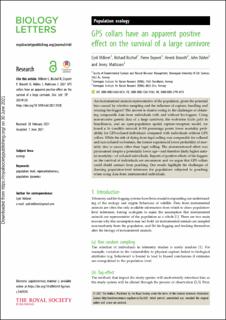GPS collars have an apparent positive effect on the survival of a large carnivore
Milleret, Cyril Pierre; Bischof, Richard; Dupont, Pierre; Brøseth, Henrik; Odden, John; Mattisson, Jenny
Peer reviewed, Journal article
Published version
Permanent lenke
https://hdl.handle.net/11250/2763083Utgivelsesdato
2021Metadata
Vis full innførselSamlinger
Originalversjon
10.1098/rsbl.2021.0128Sammendrag
Are instrumented animals representative of the population, given the potential bias caused by selective sampling and the influence of capture, handling and wearing bio-loggers? The answer is elusive owing to the challenges of obtaining comparable data from individuals with and without bio-loggers. Using non-invasive genetic data of a large carnivore, the wolverine (Gulo gulo) in Scandinavia, and an open-population spatial capture–recapture model, we found a 16 (credible interval: 4–30) percentage points lower mortality probability for GPS-collared individuals compared with individuals without GPS collars. While the risk of dying from legal culling was comparable for collared and non-collared wolverines, the former experienced lower probability of mortality due to causes other than legal culling. The aforementioned effect was pronounced despite a potentially lower age—and therefore likely higher natural mortality—of collared individuals. Reports of positive effects of bio-loggers on the survival of individuals are uncommon and we argue that GPS collars could shield animals from poaching. Our results highlight the challenges of drawing population-level inferences for populations subjected to poaching when using data from instrumented individuals. ecology, population level, representativeness, population dynamics
